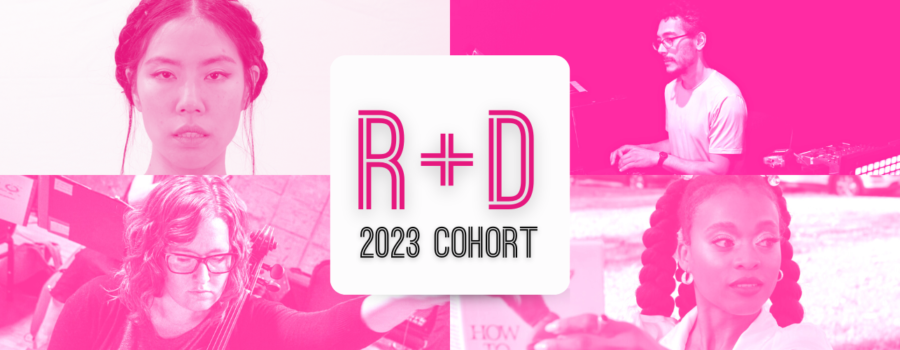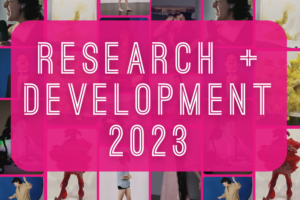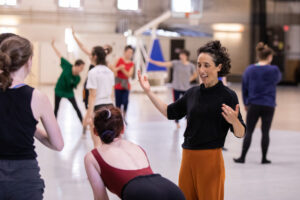L.A. Performance Practice is excited to introduce the Los Angeles-based artists invited to participate in the 2023 RESEARCH + DEVELOPMENT (R+D) and R+D: For Parents/Guardians Program.
R+D artists:
- Shauna Davis (she/her)
- Sharon Chohi Kim (she/her)
R+D: For Parents/Guardians:
- Jennifer Bewerse (she/her)
- Daniel Corral (he/him)
We received 47 interest forms this year, and all proposals were reviewed by previous R+D artists Mireya Lucio, Lindsey Red-tail, and Col of Beck + Col, along with Marketing Specialist Ximón Wood and Director of Programs Patricia Garza.
Through R+D, we aim to provide seed support to artists who are committed to live performance, and who are looking to develop their work locally. R+D matches artists with their needs through direct collaboration. Our mission continues to be anchored by a devotion to the production and presentation of contemporary performance by artists whose work advances and challenges multi-disciplinary artistic practices.
R+D artists will each receive $1,600 in support for early research and development toward a new project, plus additional resources ranging from access to rehearsal space, collaborator stipends, equipment, and producing consultations. For Parents/Guardians artists will receive a $1,200 stipend, a $800 contribution towards childcare expenses, and one week in a work/rehearsal space. Each project’s development is self-guided, and tailored specifically to each artists’ needs. The For Parents/Guardians program is made possible with support from the Sustainable Arts Foundation.
R+D Artist Shauna Davis

Bio
Originally from South Florida, Shauna Davis is a creator, dancer, and filmmaker based in Los Angeles. In creation, Shauna makes cinematic and storied dance experiences influenced by history and the fantasy of the future. She was a 2020-2021 Resident Artist with La MaMa Experimental Theatre Club and has presented work at Dallas Black Dance Theatre, Opera Omaha, LA Opera, and The MOCA Geffen, among others. Through movement and storytelling, Shauna finds alternate and colorful ways to express the nuances of being, while encompassing themes of legacy, reclamation and popular culture. As a dancer, Shauna has worked with artists such as The Weeknd, Olivia Rodrigo, & Shawn Mendes and has performed with No)One. Art House, LA Opera, Long Beach Opera and LA Chamber Orchestra. She is a graduate of New World School of the Arts and Southern Methodist University, Meadows School of the Arts.
Seeds
For a time, I’ve considered myself the black sheep of the family- a dance artist from a Black family with roots in the Miami area since the 1900s. But that’s not necessarily true. My grandmother spent over three decades as an elementary school teacher, but long before that she was an Overtown neighborhood vocal star, selling out churches and halls and opening shows for others before the age of ten. And in fact, mostly all members of my family were gifted musicians at certain points in their lives. I’m curious about their dreams. I’m curious about how their past artistic & other selves, from the 1930’s- now, has led me to the path of pursuing my own artistry. I’m curious about the life cycle and metamorphosis of dreams — which ones died so others could live? Are dreams important? and what role did the climate of Miami and our other origin cities play in this? As much as we sing, dance and sit playing cards, we never seem to talk about past ambitions, heartbreak, wishes or desires. Through interviews & research, I will explore this in addition to the dances from my family’s younger lives — merging this with the contemporary, jazz and modern dance vocabularies that were the roots of my formal dance education and the intuitive movement and heartbeat growing up in Black churches, family gatherings and culture has given us. I will allow a conversation between words and movement to take place through live performance and film. I at some point was a dream of my most recent ancestors- and I share mine with others through touch and connection.
R+D Artist Sharon Chohi Kim

Bio
Sharon Chohi Kim’s work as a voice artist, performer and composer includes immersive experimental opera, performance art, improvisation, sound art and site-specific space activation through movement and voice. As a Korean American female artist, she is interested in human connection across cultures and generations, transgenerational trauma of the Korean diaspora, and domestic and sexual violence. By engaging in the act of breathing as a right, she uses the voice and body as a direct channel of protest and resistance. She fills spaces with sonic vibrations, exploring relationships between people and the space in which they occupy, inquiring into healing between humans and the earth. Through improvisation, she explores human and non-human states of being, enthusiastically discovering new ways in which her voice can sound. Sharon Chohi has performed with the LA Philharmonic, the Industry Opera Company, Long Beach Opera, MOCA, at Walt Disney Hall, the Broad Museum, the Getty Center and Villa, in caves, tunnels, mountains, gardens, and in water.
Haenyeo
This interdisciplinary performance will include vocalizations, movement and underwater sounds through hydrophones and electronics. This piece will musically explore marine animal sounds that compete with ambient noise from industrial activity, precipitation and natural disasters. I am interested in vocalists embodying women divers from the matriarchal society of Jeju Island in South Korea, called haenyeo, who free dive daily to harvest seafood. These haenyeo are known to perform rituals to their sea goddess in return for her protection while they dive. These women work to protect marine life as they follow strict rules about how much and when they are allowed to harvest certain types of seafood. The number of haenyeo has decreased in the past few decades, as the ocean becomes more polluted by industrial development. In this hydro-opera, I would like to inquire into this symbiotic relationship between the haenyeo and the ocean, and between humans and the earth, diving into themes of ecological conservation and marine habitat loss.
R+D For Parents/Guardians Artist Jennifer Bewerse

Bio
Jennifer Bewerse is a multi-media artist and performer whose work is informed by her background as a musician. She sees herself as a collagist where she collects and arranges the elements of each piece of music, art, or performance then draws them into conversation with each other to generate collective moods and make space for listeners to draw new connections in their perspectives and experiences. As an award-winning cellist she has premiered over 150 works and is described as “[drawing] from her instrument every possible sound short of a human voice” (WholeNote). Performance highlights including the Walt Disney Concert Hall, Isabella Stuart Gardner Museum, REDCAT, Monday Evening Concerts, CAP UCLA, Wende Museum, and Banff Centre Chamber Music Residency. Her projects have been supported by awards from The Eastside Arts Initiative, Earl Brown Foundation, Center for Cultural Innovation, New Music USA, Women’s International Study Center, and the Human Resources Time Space Money Residency, and she was recently a guest artist at the Fivesparks Harvard Music Festival.
Double Spaces
Heather Barnes and Jennifer Bewerse were in a long-distance soprano and cello duo for 10 years. In March 2020, Heather was diagnosed with terminal breast cancer. In the 14 months between Heather’s diagnosis and death, they created art together driven to by a need to memorialize our friendship and grieve Heather’s diagnosis and her coming death. The materials they created are permeated with dualism: their duo collaboration, the separate places they lived in, live and recorded sounds, the past and present, grief and hilarity, the extraordinary and mundane, memories and future dreams, life and death. Double Spaces forms these materials into a live performance that shows the rich, messy, and complicated last moments of their friendship in a way that demonstrates the importance and impermanence of relationships in our lives and confronts the death denialism and sanitization that permeates dominant US culture. Our future isn’t promised.
R+D For Parents/Guardians Artist Daniel Corral

Bio
Daniel Corral is a mixed heritage Filipino-American composer/performer born and raised in Eagle River, Alaska. Based in Los Angeles since 2005, his creative practice draws inspiration from Marshall McLuhan’s definition of art as “exact information of how to rearrange one’s psyche in order to anticipate the next blow from our own extended faculties.” This manifests via combinations of pop culture and experimental music conceptual rigor; unique instrumentation; performances in outdoor and/or public spaces; microtonality; consideration of the relational values of performances; and pieces that address current issues like climate change, race relations, or online anonymity.
Corral’s music has been commissioned and presented by venues such as the BAM’s Next Wave Festival, Sundance Film Festival, Banff Centre, Joe’s Pub, REDCAT, Iceland University of the Arts, Mengi, Harpa, MATA, HERE Arts Center, Miami Light Project, Operadagen Rotterdam, Wayward Music, Walt Disney Concert Hall, Hammer Museum, MoCA LA, Göteborg Art Sound Festival, USC, Center for New Music, CSUN, Pianospheres, Automata, Machine Project, SASSAS, the wulf., Pasadena All Saints Choir, Santa Monica GLOW Festival, CalArts, UCSD, Carlsbad Music Festival, and the Marin Headlands Center for the Arts.
Corral taught at CalArts 2016-2020. In 2022, the city of Los Angeles awarded him an “Individual Master Artist” grant, after having declared him a Cultural Trailblazer in 2019. Past residencies include APPEX, Marin Headlands Center for the Arts, I-Park, the Banff Centre, Djerassi, and Loghaven. His music has been released by Populist Records, Orenda Records, Innova Recordings, the wulf. records, MicroFest Records, and independently. His MFA is from CalArts, where his teachers included James Tenney and Anne LeBaron. Corral is also Operations Director of the Grammy-winning PARTCH Ensemble, on the board of MicroFest LA, and Co-Artistic Director of the Now Hear Ensemble.
9 for 60
9 for 60 is a musical composition that builds on 2 past projects featuring custom-built instruments: 5 for 40 (2020) and 4 for 20 (2022). For 5 for 40, I built 5 instruments from a set of 40 wooden organ pipes taken from a demolished church organ. For 4 for 20, I created a set of 20 microtonal chimes from steel pipe.
I plan to accomplish 2 primary tasks:
1. Redesign and rebuild the 5 for 40 instruments
The current 5 for 40 instruments were designed quickly for a single performance, but I’ve since had several opportunities for performances and recording. In this first version, the instruments are held together with zip ties, and I hope to create plexiglass stands that will be more durable and visually interesting. The design I have in mind is inspired by the instruments of Harry Partch, which I have access to through my work as Operations Director of the Partch Ensemble.
2. Design and physically implement a microtonal tuning for the 5 for 40 organ pipes so that I can compose a piece pairing them with my 4 for 20 chimes
In order to compose 9 for 60—a piece that incorporates my chimes and pipes—the instruments need to be in the same tuning. The 4 for 20 chimes are tuned to a special microtonal tuning called a 1•3•5•7•9•11 Eikosany, based on the speculative music theory of the late SoCal-based Erv Wilson. Meanwhile, the 5 for 40 pipes are tuned to standard Western tuning (AKA 12TET). The task of designing a multi-octave tuning system and then physically altering my current instruments to implement that system is a detailed, in-depth process that having a 10-month old baby has made it difficult to carve out the time, space (and brain space) for. An LAPP R+D residency would give me that time and space to do this.
The pandemic focused my work on questions of relational values and the embodiment of sound. These questions include: Can dismantling and repurposing a church organ—refered to by Machaut as the “king of instruments”—relate to the democratization of political power? Can a musical practice based on microtonality relate to questioning the invisible nature of dominant cultural paradigms? Can the physicality of musical intervals be translated into rhythmic relationships? How can something as prescriptive as a musical composition allow for individual performers’ own physicality to influence the performance while retaining the composition’s identity as a structured work?
In addition, my use of microtonality explores my research into the history of microtonal music in Southern California. This history is poorly documented because most of its participants hold anti-authoritarian and often anti-academic views that kept them deliberately away from institutional support. The music theory concepts I’m exploring come from personal research and interviews I’ve conducted with these artists since 2018.




